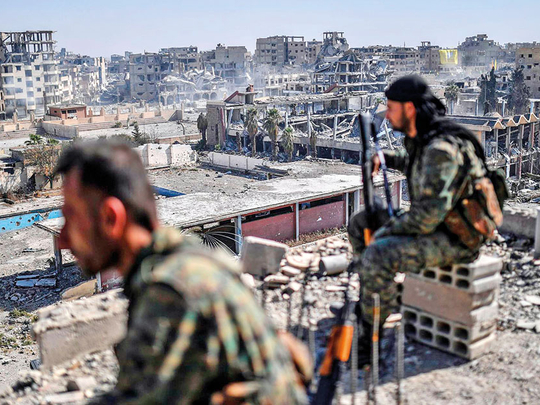
Beirut: The last vestige of Daesh territory in Syria came under attack, as members of a US-backed coalition said Tuesday that they had begun a final push to oust the militants from Hajin, the remaining sliver of territory under the group’s control in the region where it was born.
The assault is the final chapter of a war that began more than four years ago after Daesh seized enormous tracts of land in Iraq and Syria and declared a ‘caliphate’.
The Syrian Democratic Forces, the Kurdish-led militia that has been fighting Daesh in Syria with the United States and its allies, said in a statement that its forces had launched an offensive on the area from four sides on Monday evening.
The caliphate put Daesh on the map both physically and politically, filling its coffers and swelling its ranks both there and abroad, where adherents committed attacks in its name.
Even if it is defeated in Hajin, however, Daesh is likely to remain a powerful terrorist force.
Hajin does not look like much: On a bend of the Euphrates River in eastern Syria, it appears to have only a few major streets and just one public hospital. An estimated 60,000 people are believed to be living there and in a smattering of neighbouring villages.
The Syrian Democratic Forces is nevertheless preparing for a slog: between two and three months, according to one senior official with the militia.
Given Hajin’s size, that may seem a surprisingly long time. Daesh-held cities with populations one and a half to three times larger, including Sinjar and Tal Afar in Iraq, fell in days.
The difference is that in those battles, Daesh made a strategic retreat, choosing to abandon their positions to consolidate and regroup. This time, retreat is not an option.
“We expect a long and hard fight,” said Col. Sean J. Ryan, a spokesman for the US-led military coalition in Baghdad. “These are the diehard fighters with nowhere else to go.”
In its remaining slip of land, Daesh has dug tunnels. Its fighters, aerial surveillance indicates, have mined the circumference of their last redoubt, laying explosive devices on the roads leading into the area.
And to facilitate escape, they have buried large quantities of cash in berms of sand and hidden weapons and ammunition in caves and underground passages, strategically positioning resources in the desert, analysts say.
The tunnels allow the militants to move from house to house, undetected from the air. Some passageways connect outposts to their military bases, said one resident reached by telephone who requested anonymity for fear of retribution.
The forces fighting Daesh on the ground are a mix of Kurdish and Arab militias that have been working closely with an international coalition led by the United States to push back the group.
The statement announcing the start of the campaign said that the coalition was providing air support for surveillance and to identify and hit targets. It was also coordinating with Iraqi artillery units to strike fixed Daesh positions, the statement said.
Once in control of territory equivalent to the size of Britain, Daesh is down to its last 200 square miles, according to Ryan. The group has lost all but 1 per cent of the territory it held in Iraq and Syria, and its caliphate appears about to be erased in the region where it was born, though it continues to grow in outposts in Asia and Africa.
It has taken more than four years, over 29,000 air strikes and thousands of soldiers’ lives for the US-led coalition to reclaim the group’s land holdings in Iraq and Syria. But Daesh remains a potent force.
Data collected by the US Department of Defence and the United Nations indicate that the group has as many fighters now as it did in 2014 — the height of the caliphate — with 20,000 to 31,500 members in Iraq and Syria alone, and thousands more spread across the numerous other countries where it has implanted itself. If those figures are accurate, they match what the CIA estimated as the group’s strength four years ago, when it ruled over a population of 12 million.
Senior officials at the Pentagon and in the White House say the real number is far lower. But a third report, to be published soon by the Centre for Strategic and International Studies, confirms the higher estimate, concluding that Daesh still has as many as 25,000 fighters.
But driving Daesh from its territory alone will not be enough to bring about their long-term defeat, officials and analysts say. Daesh remains capable of wreaking damage around the world simply by inspiring adherents to take up a gun, a bomb or even a car. And in Iraq and Syria, the group has reverted to an insurgency.
“The easy part is done, which is removing Daesh from the cities it controlled,” said Michael Knights, a senior fellow at the Washington Institute for Near East Policy. “Now comes the hard part.”
Throughout cleared areas, Daesh members are believed to have melted back into the population. They move and hide in cells made up of a handful of fighters, and occupy a network of safe houses, analysts say.
The forces that drove Daesh from its lands were equipped to liberate occupied cities, not fight a dispersed, clandestine force. Their vehicles and weapons were designed for engaging the enemy frontally in heavy combat, not for rooting out individual fighters in hiding.
“It’s evolved back into an insurgent movement far faster than security forces can evolve into a counterinsurgency,” Knights said.












